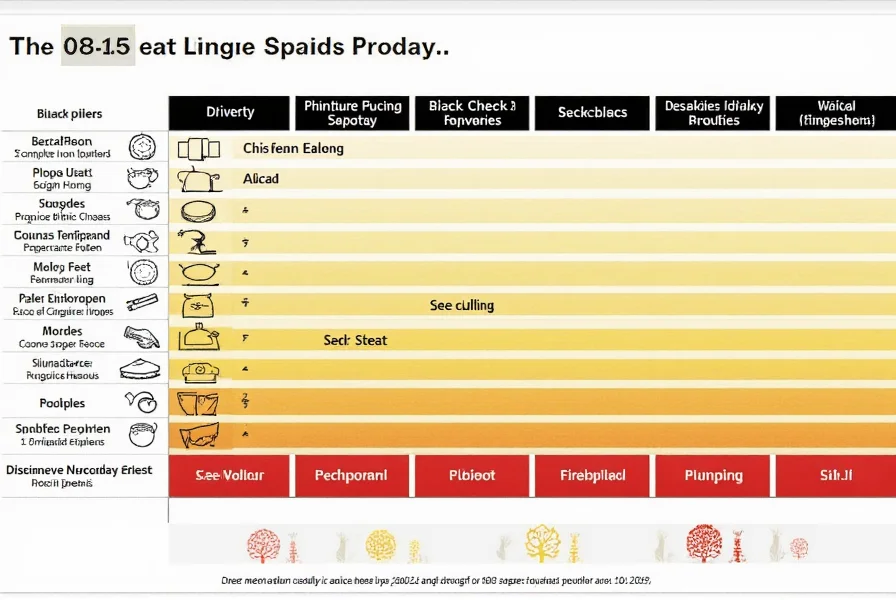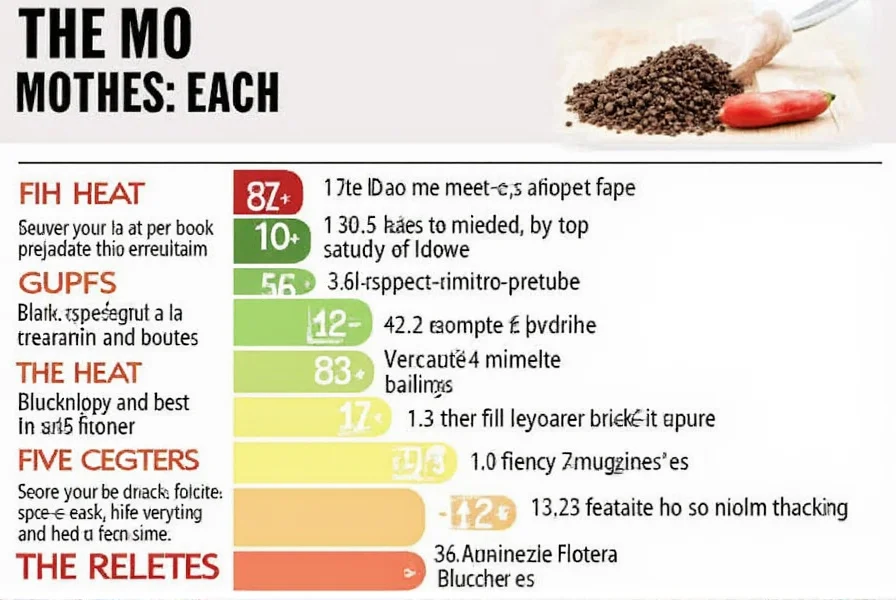Unlike chili peppers measured on the Scoville scale, black pepper does not have a standardized numerical heat scale. Instead, its heat level is described qualitatively based on sensory experience and chemical composition. The primary compound responsible for black pepper's bite is piperine — a mild alkaloid that triggers a warm, tingling sensation rather than outright spiciness.
Table of Contents
- How Black Pepper Heat Works
- How Does It Compare to Other Spices?
- Factors Affecting Spice Levels
- Practical Tips for Using Black Pepper
- Buying Guide: Choosing the Right Black Pepper
- Frequently Asked Questions
- Final Thoughts
How Black Pepper Heat Works
Black pepper's heat comes from piperine, which activates different receptors in the mouth than capsaicin (found in chili peppers). This creates a warming sensation without the burning pain associated with chilies. Unlike Scoville units, heat levels are categorized qualitatively:
- Mild – Freshly cracked white or light brown peppercorns
- Moderate – Regular black peppercorns, freshly ground
- Strong – Dark roasted or long-aged peppercorns
How Does It Compare to Other Spices?
To better understand where black pepper falls on the heat spectrum, let's compare it with other common spices using relative rankings:
| Spice | Heat Level (Relative) | Primary Compound | Typical Use |
|---|---|---|---|
| Black Pepper | Mild to Moderate | Piperine | Everyday seasoning |
| Cayenne Pepper | Hot | Capsaicin | Spicy dishes |
| Jalapeño | Moderate-Hot | Capsaicin | Mexican cuisine |
| Szechuan Pepper | Moderate + Tingling | Hydroxy-alpha-sanshool | Asian stir-fries |
| White Pepper | Milder | Piperine | Cream sauces, soups |
Visual Comparison Chart

Factors Affecting Spice Levels
Several elements influence how hot or mild your black pepper tastes. Here's what affects the heat intensity:
- Peppercorn Maturity: Fully matured black peppercorns have more concentrated piperine.
- Roasting/Toasting: Lightly roasting enhances aroma but can increase the spicy bite.
- Grind Size: Coarsely cracked pepper delivers a bolder punch; finely ground offers a smoother spread of heat.
- Freshness: Whole peppercorns retain potency longer than pre-ground varieties.
Practical Tips for Using Black Pepper
If you're ready to take your kitchen game up a notch, here are some easy yet effective ways to harness the power of black pepper:
- Crack It Yourself: Invest in a good pepper mill. Whole peppercorns stay fresher and pack more punch when freshly cracked.
- Add at the End: Piperine is volatile. Add black pepper toward the end of cooking to preserve its flavor and heat.
- Pair with Fats: Piperine dissolves in fat. Adding black pepper to butter, oil, or cream helps distribute the heat evenly.
- Experiment with Roasted Peppers: Toast peppercorns lightly before grinding to unlock deeper, slightly spicier notes.
- Use Different Varieties: Try Tellicherry or Sarawak pepper for distinct heat profiles and complex flavors.
Buying Guide: Choosing the Right Black Pepper
Not all black pepper is created equal. Here's how to choose the best one for your needs based on heat, flavor, and usage:
| Product | Flavor Profile | Heat Level | Best For | Occasion |
|---|---|---|---|---|
| Tellicherry Black Pepper | Earthy, woody, bold | Moderate to Strong | Red meats, stews, rubs | Dinner parties, gourmet cooking |
| Sarawak Black Pepper | Fruity, floral, mellow | Moderate | Seafood, risottos, creamy pasta | Weeknight meals, casual dining |
| Muntok White Pepper | Elegant, smooth, less harsh | Mild | Cream sauces, mashed potatoes, soups | Delicate dishes, refined palates |
| Malabar Black Pepper | Classic, sharp, balanced | Moderate | Everyday seasoning, marinades | General cooking, family meals |
| Roasted Black Pepper | Nutty, smoky, rich | Strong | Grilled meats, BBQ rubs, hearty dishes | Outdoor grilling, fall/winter meals |
Top Picks Based on Needs
- For Everyday Use: Malabar Black Pepper – Balanced and affordable.
- For Gourmet Cooking: Tellicherry Black Pepper – Bold and aromatic.
- For Subtle Dishes: Muntok White Pepper – Mild and elegant.
- For Smoky Flavors: Roasted Black Pepper – Adds depth and warmth.
- For Seafood Lovers: Sarawak Black Pepper – Perfect for enhancing lighter proteins.

Frequently Asked Questions
Common Questions About Black Pepper Heat
Is there a Scoville scale rating for black pepper?
No, black pepper doesn't use the Scoville scale which is designed for capsaicin in chili peppers. Instead, black pepper's heat comes from piperine and is generally considered mild to moderate on the spice spectrum. The Scoville scale measures capsaicin intensity, while black pepper's heat works through a different compound and sensory experience.
How hot is black pepper compared to chili peppers?
Black pepper is significantly milder than most chili peppers. While jalapeños range from 2,500-8,000 Scoville units and cayenne pepper reaches 30,000-50,000 units, black pepper's piperine doesn't register meaningfully on the Scoville scale. Black pepper creates a warming sensation rather than the burning heat associated with chilies.
Why does my black pepper taste different in heat level sometimes?
Several factors affect black pepper's heat: peppercorn maturity (fully matured have more piperine), roasting/toasting (enhances spicy bite), grind size (coarse delivers bolder punch), and freshness (whole peppercorns retain potency). Different varieties like Tellicherry or Sarawak also have distinct heat profiles.
What's the difference between black pepper and white pepper heat levels?
White pepper is generally milder than black pepper because the outer layer containing most piperine is removed during processing. Black pepper delivers a more pronounced, complex heat with earthy notes, while white pepper offers a cleaner, sharper but less intense heat that works better in light-colored dishes.
Does grinding black pepper finer make it hotter?
Not exactly hotter, but finer grind distributes the piperine more evenly, creating a more consistent heat experience throughout your dish. Coarse cracks provide more intense but localized heat bursts. For immediate heat impact, coarse grind works better; for subtle, even distribution, fine grind is preferable.
Why doesn't black pepper make my mouth burn like chili peppers do?
Black pepper's piperine creates a warming sensation rather than the burning sensation from capsaicin in chili peppers. It activates different receptors in your mouth (TRPV1 channels) that produce warmth rather than pain. This is why black pepper feels 'hot' but not painful like extremely spicy chilies.
Final Thoughts
Black pepper might not set your mouth on fire like a ghost pepper, but its unique heat profile makes it indispensable in any well-stocked kitchen. Understanding the nuances of black pepper's qualitative heat description allows you to control the balance of flavor and warmth in your dishes.
Whether you're sprinkling it over scrambled eggs or crafting a complex spice rub, a little knowledge about this humble spice goes a long way. So next time you reach for that pepper mill, remember — every grind brings a chance to enhance your food and delight your taste buds.
Happy cooking, and may your meals always carry a hint of warmth!










 浙公网安备
33010002000092号
浙公网安备
33010002000092号 浙B2-20120091-4
浙B2-20120091-4